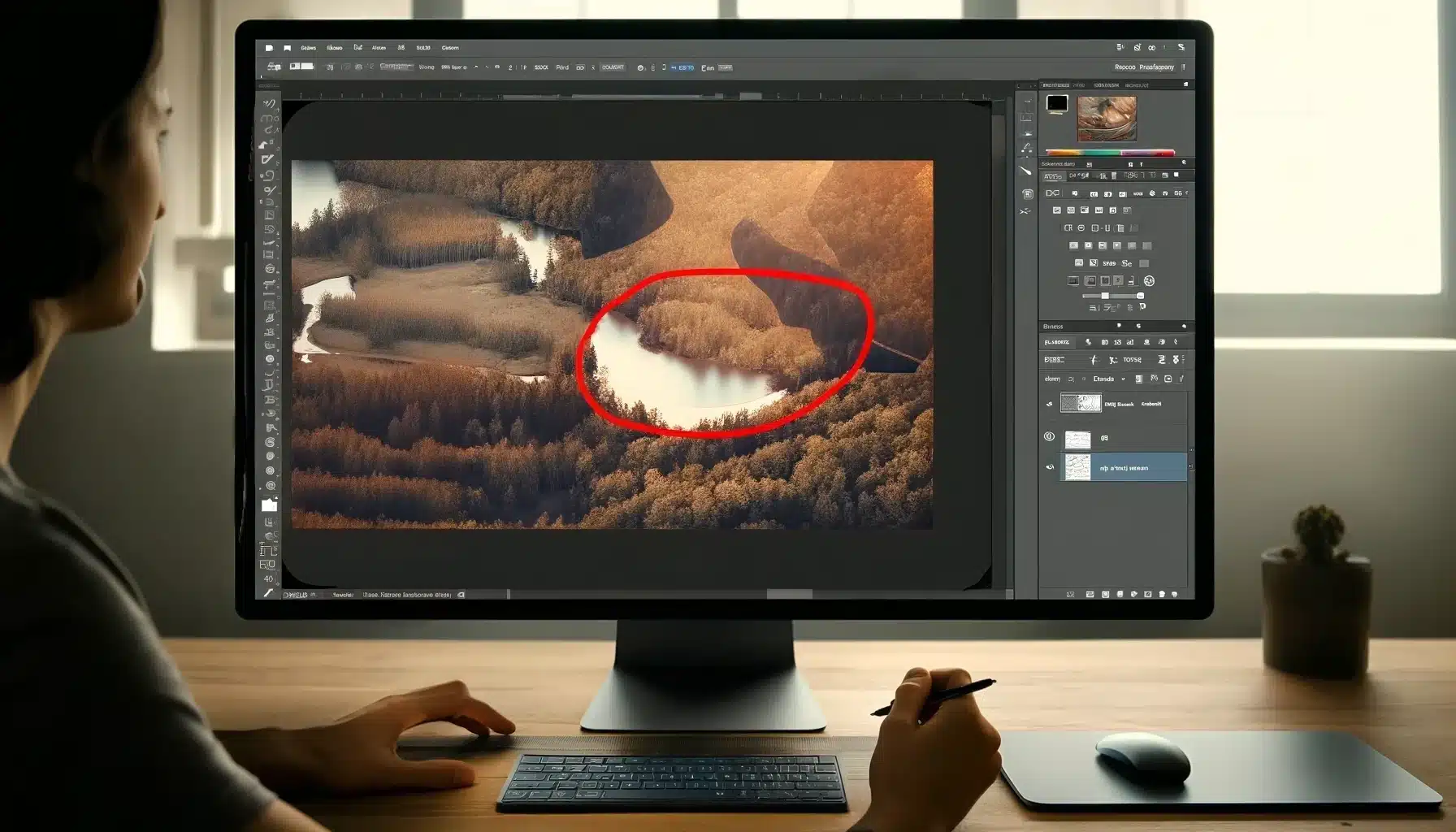
Mastering the art of zooming in Adobe Photoshop is at the pinnacle of this craft.
This article serves as a beginner’s guide to one fundamental aspect for users—zooming in on Photoshop.
Navigating your way around an image using the zoom tool can significantly streamline your editing process.
Research reveals that approximately 65% of people are visual learners; thus, understanding how to efficiently use Photoshop shortcuts like Ctrl + for Windows or Command + for Mac can drastically improve productivity.
The journey to honing these skills starts with learning how to employ the hand and scroll wheel tools effectively and getting comfortable with the options bar.
Therefore, this will enable you to alter your view swiftly without losing sight of crucial details that require attention.
Table of Contents
Mastering Zoom in Adobe Photoshop
Transitioning from a broad understanding of the program’s capabilities, let’s focus on a specific yet powerful feature: navigating your canvas with precision as users.
Thats why this section will explore lesser-known techniques allowing you to manipulate your view with ease and accuracy.
Introduction to Zoom Functionality
When working with intricate details or large compositions, controlling your viewpoint is essential.
Beyond the basic commands, Photoshop offers a suite of functionality that goes unnoticed by many.
Let’s dive into some of these options:
- Utilize the 'Navigator Panel' to see your artwork from a bird's-eye. It allows you to click and drag to the area of interest swiftly.
- Explore the 'Zoom All Windows' feature if you're working with multiple images, ensuring all open files are magnified simultaneously for a cohesive see.
- Discover the 'Animated Zoom' for a smoother transition, giving you more dynamic control over your zooming actions. Suggest placing an image here showing the Navigator Panel in use.
Understanding zoom functionality in Photoshop starts with capturing the perfect shot, and the lens you choose plays a pivotal role.
Before diving into zoom commands, beginners might benefit from exploring how to choose which camera lens to buy, ensuring they capture the highest quality images for editing.
Essential Zoom Commands for Beginners
For those starting users, mastering a few key commands can significantly speed up your editing process.
Here are some foundational step in the menu to incorporate into your routine:
- Remember the simple 'Zoom In' and 'Zoom Out' keyboard shortcuts – they will be your frequent tools. Zoom In/Out: Ctrl/Cmd + Plus/Minus
- Learn how to quickly 'Fit on Screen' to reset your perspective after zooming in on details. Fit on Screen: Ctrl/Cmd + 0
- Use the 'Zoom Toggle' technique to switch between your last two zoom levels, optimizing your navigation while editing. Zoom Toggle: Double-click on the Zoom Tool
Accessing Zoom with Different Tools
Photoshop’s versatility allows for multiple methods to adjust your view, each with its unique advantages.
Here’s how you can leverage these tools in the menu for an efficient workflow:
- First, the 'Hand Tool' works in tandem with zooming, enabling you to move around a zoomed-in image effortlessly.
- Then, 'Zoom with Scrubby Slider' provides a click-and-drag functionality that can be a game-changer for quick magnification adjustments.
- Lastly, keyboard aficionados can combine the 'Spacebar' with 'Cmd/Ctrl' to temporarily switch to the 'Zoom Tool' without disrupting their workflow.
Therefore, incorporating these techniques into your daily use of Adobe Photoshop will improve the speed of your work and the precision with which you execute your creative vision.
Whether you’re retouching a single photo or juggling multiple layers in a complex composition, these zoom strategies are fundamental to a seamless editing experience.
To further enhance your Photoshop skills, consider exploring our tutorial on Selection Tools in Photoshop. These tools complement the zoom functions by allowing precise edits.
Or, if you’re looking to expand your creative toolkit, our comparison between Photoshop vs Illustrator might provide valuable direction.
Advanced Zoom Techniques

As we build upon the foundational knowledge of zoom functions in Photoshop, we shift our focus to more sophisticated techniques that streamline workflows and enhance the process.
Shortcuts for Efficient Zoom Management
A keyboard shortcut is the lifeline of an efficient Photoshop user. Memorize these key combinations to speed up your zooming tasks:
- Click 'Ctrl' (CMD on Mac) and '+' to zoom in or 'Ctrl' (CMD on Mac) and '-' to zoom out.
- 'Ctrl' (Cmd on Mac) and '0' will fit your image to the screen, while 'Ctrl' (Cmd on Mac) and '1' will return you to 100% magnification.
- Hold down 'H' and click on the canvas to temporarily switch to the Hand tool, drag it to your desired location, and release it to snap back to the Zoom tool.
By mastering this shortcut, you can swiftly navigate through various zoom levels, keeping your workflow smooth and uninterrupted.
Mastering these keyboard shortcuts not only makes your workflow in Photoshop more efficient but also reduces the time spent on manual zooming and navigation.
By integrating these shortcuts into your daily routine, you enhance your productivity, allowing for more focus on creative aspects of your work.
Efficient zoom management leads to a more streamlined process, helping you achieve precise edits with less effort and time.
Furthermore, familiarizing yourself with these shortcuts can significantly improve your speed, giving you an edge in professional environments where time is of the essence.
This efficiency not only contributes to higher quality work and a more satisfying top experience but also fosters a deeper understanding of the software, enabling users to explore more advanced features with confidence, which in turn can lead to innovative design solutions and enhanced creative output.
To uplift your expertise, you might also find value in our comprehensive course about Photoshop’s essential skills.
Zooming with the Hand Tool
- First, click and hold the 'H' key to temporarily switch to the Hand tool while another tool is active.
- Then, click and drag your image to reposition your view.
- Lastly, release the 'H' key to revert to your previous tool.
This technique is perfect for maintaining your focus on editing while efficiently scanning different parts of your image.
Also, these advanced zoom techniques provide a robust set of skills that can significantly improve your efficiency in Adobe Photoshop.
By integrating these methods into your editing routine, you’ll ensure a smoother, more controlled experience as you refine your images to perfection, allowing you to navigate through layers and details with ease and precision.
Pro Tip: Familiarize yourself with Photoshop’s shortcuts such as the new layer shortcut in order to make your workflow even faster!
Zoom Out Strategies for Photoshop Users
Exploring advanced strategies for zooming out in Photoshop can significantly streamline your process.
Whether you’re working on intricate designs or large-scale photos, these techniques will help you navigate your workspace with precision and speed.
Customizing Zoom Preferences for Efficiency
Tailoring your Photoshop experience starts with adjusting the zoom preferences to fit your workflow.
By navigating to the Preferences menu, you can alter the zoom increments to suit your project needs.
Therefore, this can be a game-changer when working on projects that require frequent zoom adjustments. Here’s how you can optimize your zoom settings:
- First, go to Edit > Preferences > Tools and find the section labeled 'Zoom'.
- Second, adjust the 'Zoom Resizes Windows' feature to control whether your window resizes with the zoom level.
- Then, set the 'Animated Zoom' option to speed up or slow down the zoom animation.
- Lastly, fine-tune the 'Scrubby Zoom' feature for a more tactile zooming experience with your mouse or tablet.
Discover how to use a different but powerful tool to perfection in our guide for patching tools in Photoshop. This will not only complement your zooming techniques but also open up a new realm of possibilities for your creative projects.
Frequently Asked Questions

How do you zoom in and out on Photoshop?
- To magnify your see in Photoshop, click Command (Mac) or Ctrl (Windows) and the Plus (+) key. Repeat the step to increase the magnification.
- For a broader perspective, press Command (Mac) or Ctrl (Windows) with the Minus (-) key. Each press will decrease the zoom level.
- Alternatively, utilize the Zoom Tool from the toolbar, which looks like a magnifying glass. Click on your image to zoom in and hold Option (Mac) or Alt (Windows) while clicking to zoom out.
- For more precision, select the Zoom Tool and draw a marquee around the area you want to enlarge.
How do you zoom using Ctrl in Photoshop?
- Holding the Ctrl key and pressing the Plus (+) or Minus (-) key allows rapid alteration of the view's scale.
- While focused on the Workspace, click Ctrl with the 0 (zero) key to fit the image to the screen, or use Ctrl with 1 to return to 100% view.
- For non-destructive zooming, keep the Ctrl key pressed and use the scroll wheel of your mouse to adjust the see smoothly.
Why can't I zoom in on Photoshop?
- Tool Selection: Ensure the Zoom Tool is selected or the appropriate Lightroom shortcuts are used. Other tools will not zoom the image.
- Document Status: Check if the document is opened properly in Photoshop. If it's not fully loaded or has encountered an error, zoom functions may be disrupted.
- Performance Issues: If the program is slow or freezing, it could be due to your computer's performance or Photoshop's preferences settings. Resetting preferences or increasing allocated memory may help.
- Graphics Processor Settings: Under preferences, the 'Use Graphics Processor' feature helps with zooming and other tasks. Ensure it's enabled for optimal performance.
How do you zoom in on a panel in Photoshop?
- To focus on a specific panel, such as Layers or Adjustments, press Ctrl while using the mouse wheel to zoom within that panel.
- Resize the panel for a clearer position by dragging its edges if more space is needed.
- Panels like 'Navigator' offer their own zoom slider and 'bird’s eye' window to control your zoom level without affecting the main workspace.
Conclusion
Mastering the zoom functionality in Adobe Photoshop has many different lenses and profoundly transformed my editing process.
Personally, I’ve found that utilizing shortcuts, especially the ‘Ctrl‘ (or ‘Cmd‘) combined with the ‘+’ or ‘-‘ keys, allows me to navigate through my projects with unprecedented speed and precision.
This skill was a game-changer in a recent project where I needed to meticulously edit a high-resolution image; the ability to zoom in and out quickly without losing focus on the finer details made all the difference.
Embracing these techniques enhances efficiency and elevates the quality of your work, allowing for a more refined final product.
If you’re keen to refine your Photoshop skills further or expand your creative toolkit, I highly recommend exploring our comprehensive Photoshop course and considering our Lightroom course for an even broader mastery of photo editing.
Embark on this journey to unlock your full creative potential, and let these courses guide you to achieving creative excellence.
Read more about Photoshop:
















